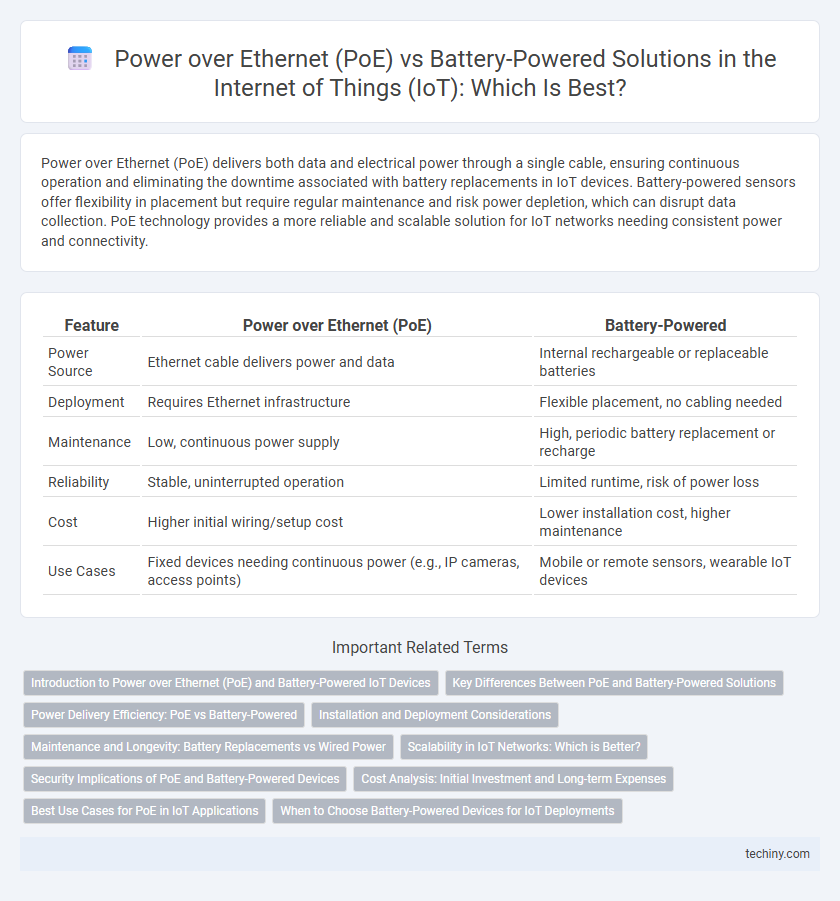Power over Ethernet (PoE) delivers both data and electrical power through a single cable, ensuring continuous operation and eliminating the downtime associated with battery replacements in IoT devices. Battery-powered sensors offer flexibility in placement but require regular maintenance and risk power depletion, which can disrupt data collection. PoE technology provides a more reliable and scalable solution for IoT networks needing consistent power and connectivity.
Table of Comparison
| Feature | Power over Ethernet (PoE) | Battery-Powered |
|---|---|---|
| Power Source | Ethernet cable delivers power and data | Internal rechargeable or replaceable batteries |
| Deployment | Requires Ethernet infrastructure | Flexible placement, no cabling needed |
| Maintenance | Low, continuous power supply | High, periodic battery replacement or recharge |
| Reliability | Stable, uninterrupted operation | Limited runtime, risk of power loss |
| Cost | Higher initial wiring/setup cost | Lower installation cost, higher maintenance |
| Use Cases | Fixed devices needing continuous power (e.g., IP cameras, access points) | Mobile or remote sensors, wearable IoT devices |
Introduction to Power over Ethernet (PoE) and Battery-Powered IoT Devices
Power over Ethernet (PoE) enables IoT devices to receive both data and electrical power through a single Ethernet cable, simplifying installation and reducing maintenance by eliminating the need for separate power supplies or battery replacements. Battery-powered IoT devices offer flexibility and mobility, allowing deployment in remote or inaccessible locations where wired power is impractical, but they require periodic charging or battery replacement, potentially increasing operational costs and downtime. Selecting between PoE and battery-powered solutions depends on factors like device location, power availability, maintenance capabilities, and overall network design.
Key Differences Between PoE and Battery-Powered Solutions
Power over Ethernet (PoE) delivers both data connectivity and electrical power through a single Ethernet cable, enabling continuous operation of IoT devices without battery replacements or downtime. Battery-powered IoT devices rely on internal energy storage, offering flexible placement but requiring regular maintenance and limited operational lifespan. PoE systems excel in stable, high-power environments with centralized power management, while battery-powered solutions suit remote or mobile applications where wiring is impractical.
Power Delivery Efficiency: PoE vs Battery-Powered
Power over Ethernet (PoE) offers higher power delivery efficiency by providing continuous, stable energy directly through Ethernet cables, eliminating energy loss associated with battery charging cycles. Unlike battery-powered IoT devices, which experience efficiency drops due to chemical energy conversion and periodic recharging, PoE ensures consistent voltage and reduced power dissipation. This efficiency advantage makes PoE ideal for IoT deployments demanding reliable, long-term power without frequent maintenance or downtime.
Installation and Deployment Considerations
Power over Ethernet (PoE) simplifies IoT device installation by combining data and electrical power through a single cable, reducing wiring complexity and eliminating the need for separate power supplies or frequent battery replacements. Battery-powered IoT devices offer greater flexibility in placement, supporting deployment in locations without access to Ethernet wiring but require regular maintenance for battery replacement and monitoring. Installation and deployment decisions must weigh PoE's stable, centralized power delivery against the autonomy and mobility offered by battery-powered solutions in varying environmental conditions.
Maintenance and Longevity: Battery Replacements vs Wired Power
Power over Ethernet (PoE) minimizes maintenance by delivering continuous wired power, reducing the need for frequent battery replacements common in battery-powered IoT devices. Battery-powered IoT solutions require periodic battery changes or recharging, increasing operational costs and potential downtime. PoE enhances device longevity and reliability by ensuring consistent energy supply, making it ideal for long-term IoT deployments.
Scalability in IoT Networks: Which is Better?
Power over Ethernet (PoE) offers superior scalability for IoT networks by providing continuous power and data connectivity through a single cable, simplifying deployment and maintenance in large-scale environments. Battery-powered devices enable flexible placement and are ideal for remote or mobile applications but face limitations in scalability due to battery life constraints and frequent replacement needs. For expansive IoT deployments requiring reliable, high-density connectivity, PoE is generally more scalable and cost-effective over time.
Security Implications of PoE and Battery-Powered Devices
Power over Ethernet (PoE) devices enhance security by enabling continuous power supply, reducing the risk of device downtime and maintaining consistent network monitoring crucial for IoT environments. Battery-powered IoT devices pose security challenges due to limited energy, leading to potential interruptions in data transmission and increased vulnerability to physical tampering during battery replacements. Implementing PoE supports centralized security management through physical network infrastructure, while battery-powered devices require more frequent maintenance and robust encryption to safeguard transmitted data against signal interception.
Cost Analysis: Initial Investment and Long-term Expenses
Power over Ethernet (PoE) deployment in Internet of Things (IoT) projects typically requires higher initial investment due to cabling and PoE-enabled switches but significantly reduces long-term operational costs by eliminating battery replacements and maintenance. Battery-powered IoT devices have lower upfront costs but incur ongoing expenses related to battery procurement, replacement labor, and environmental disposal, which accumulate substantially over time. Cost analysis favors PoE for large-scale, permanent IoT installations where longevity and reduced maintenance drive overall savings.
Best Use Cases for PoE in IoT Applications
Power over Ethernet (PoE) is ideal for IoT applications requiring continuous, reliable power and data transmission, such as smart building automation, IP surveillance cameras, and industrial sensors. PoE eliminates battery dependency, reducing maintenance costs and downtime in environments where frequent battery replacement is impractical. This technology excels in installations with existing Ethernet infrastructure, enabling seamless integration of IoT devices with centralized power management for enhanced operational efficiency.
When to Choose Battery-Powered Devices for IoT Deployments
Battery-powered IoT devices are ideal when flexibility, remote installation, or locations without reliable wiring infrastructure are priorities, enabling easy deployment in hard-to-reach areas. These devices support mobility and temporary setups where constant power supply via Power over Ethernet (PoE) is unavailable or impractical. In scenarios requiring low power consumption and intermittent data transmission, battery-powered solutions minimize maintenance costs and downtime compared to PoE alternatives.
Power over Ethernet (PoE) vs Battery-powered Infographic

 techiny.com
techiny.com